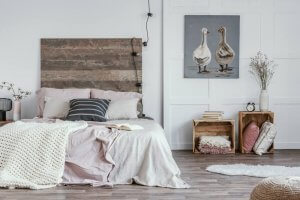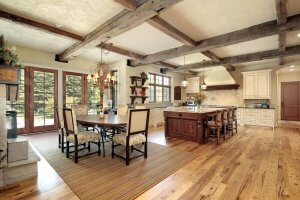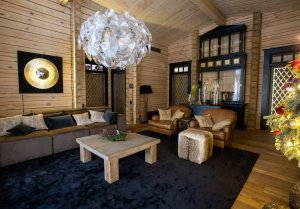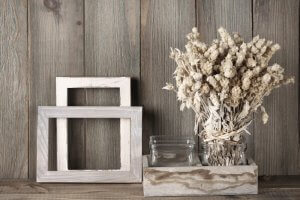Traditional Decor - Reviving the Customs of the Past

Throughout history, the world of interior design has produced hundreds of new trends, which have given rise to a vast array of styles. Today, we want to delve into the past, and show you how you can create traditional decor in your home.
Country houses are the perfect place to use this type of decor. In this article, we will be taking inspiration from the classic design trends of the 18th and mid-19th Century.
However, using traditional decor doesn’t mean reverting back to the styles used by our great-great-grandparents. The idea is to use this look as a source of inspiration, incorporating traditional elements into versatile modern styles which allow you to combine a variety of different resources.
What is traditional decor?

The word “tradition” is normally used to refer to historically or culturally significant practices that are upheld year after year. It is closely associated with two other concepts: custom and history. Choosing to use the traditional style in your home could, therefore, be seen as a process of revival and preservation.
To understand what traditional decor is, we first need to look at how our ancestors decorated their homes. You don’t need to resort to using archaic elements – the aim is to choose items that will give your home that special touch.
This style is commonly associated with rural settings. Here, there is a close relationship between the home and nature, and it is common to see furniture made from natural, locally-sourced materials.
It’s important to revive the design trends of the past, before we lose them altogether.
5 must-have elements

If you want to give your home that distinctive traditional feel, there are a few items you need to keep in mind:
1. Wooden furniture is an essential part of traditional decor. Nightstands are a must and work well when placed in the corner of the room. Though they won’t be overly prominent here, combining them with matching furniture is a great way to give your bedroom a charming, rustic look.
2. Upholstered or velvet armchairs: these classic chairs are perfect for enhancing that traditional aesthetic and are a great place to sit back and relax after a hard day’s work.
3. Photos on the walls: whether family photos or famous landscapes, photos are a great way to decorate shelves and tables, and were used throughout the 20th century.
4. Wooden or wrought iron chairs are both charming and practical. Plus, using materials that are typical of the rural world is a great way to create that traditional feel.
5. You can even use vintage farm tools to decorate your walls and shelves. Whether a rake, plow, or yoke, these can be a great addition to traditional spaces, helping to create a really authentic and rustic feel.
Wooden or stone floors

If you want to give your home that traditional look, you need to ask yourself one important question: which type of flooring will work best? Wood is a material that works really well in rustic-style environments and is a good option for traditional-style homes. However, it’s important to choose wood that offers a certain sense of antiquity.
Stone is another valid option. While it can offer a more natural and attractive aesthetic than wood, it does come with one large downside: it’s very cold and doesn’t retain heat. However, it can be a good way to accentuate that traditional feel, creating that authentic 19th Century country cottage vibe.
Traditional decor: earth tones

If you want to get the traditional look in your home, you need to pay close attention to the colors. Earth tones work best with this look, as they were the most popular choices for country cottages in the 18th and 19th centuries.
The most interesting options include brown, maroon, beige and terracotta. All these can work really well here, and combine perfectly with the gray tones of traditional stone houses. Your main goal is to use these colors to create a space that is warm and welcoming.
Throughout history, the world of interior design has produced hundreds of new trends, which have given rise to a vast array of styles. Today, we want to delve into the past, and show you how you can create traditional decor in your home.
Country houses are the perfect place to use this type of decor. In this article, we will be taking inspiration from the classic design trends of the 18th and mid-19th Century.
However, using traditional decor doesn’t mean reverting back to the styles used by our great-great-grandparents. The idea is to use this look as a source of inspiration, incorporating traditional elements into versatile modern styles which allow you to combine a variety of different resources.
What is traditional decor?

The word “tradition” is normally used to refer to historically or culturally significant practices that are upheld year after year. It is closely associated with two other concepts: custom and history. Choosing to use the traditional style in your home could, therefore, be seen as a process of revival and preservation.
To understand what traditional decor is, we first need to look at how our ancestors decorated their homes. You don’t need to resort to using archaic elements – the aim is to choose items that will give your home that special touch.
This style is commonly associated with rural settings. Here, there is a close relationship between the home and nature, and it is common to see furniture made from natural, locally-sourced materials.
It’s important to revive the design trends of the past, before we lose them altogether.
5 must-have elements

If you want to give your home that distinctive traditional feel, there are a few items you need to keep in mind:
1. Wooden furniture is an essential part of traditional decor. Nightstands are a must and work well when placed in the corner of the room. Though they won’t be overly prominent here, combining them with matching furniture is a great way to give your bedroom a charming, rustic look.
2. Upholstered or velvet armchairs: these classic chairs are perfect for enhancing that traditional aesthetic and are a great place to sit back and relax after a hard day’s work.
3. Photos on the walls: whether family photos or famous landscapes, photos are a great way to decorate shelves and tables, and were used throughout the 20th century.
4. Wooden or wrought iron chairs are both charming and practical. Plus, using materials that are typical of the rural world is a great way to create that traditional feel.
5. You can even use vintage farm tools to decorate your walls and shelves. Whether a rake, plow, or yoke, these can be a great addition to traditional spaces, helping to create a really authentic and rustic feel.
Wooden or stone floors

If you want to give your home that traditional look, you need to ask yourself one important question: which type of flooring will work best? Wood is a material that works really well in rustic-style environments and is a good option for traditional-style homes. However, it’s important to choose wood that offers a certain sense of antiquity.
Stone is another valid option. While it can offer a more natural and attractive aesthetic than wood, it does come with one large downside: it’s very cold and doesn’t retain heat. However, it can be a good way to accentuate that traditional feel, creating that authentic 19th Century country cottage vibe.
Traditional decor: earth tones

If you want to get the traditional look in your home, you need to pay close attention to the colors. Earth tones work best with this look, as they were the most popular choices for country cottages in the 18th and 19th centuries.
The most interesting options include brown, maroon, beige and terracotta. All these can work really well here, and combine perfectly with the gray tones of traditional stone houses. Your main goal is to use these colors to create a space that is warm and welcoming.
All cited sources were thoroughly reviewed by our team to ensure their quality, reliability, currency, and validity. The bibliography of this article was considered reliable and of academic or scientific accuracy.
- Lava Oliva, Rocío: Interiorismo, Vértice, 2008.







